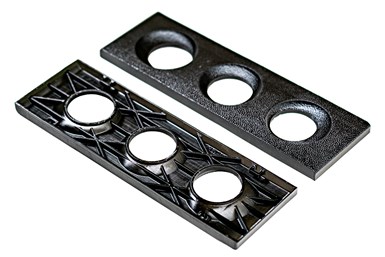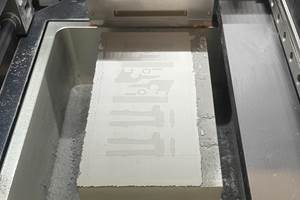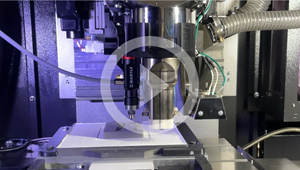3D Systems Materials Expand Capabilities of SLA, Figure 4 Platforms
3D Systems’ latest high-performance materials can enable efficient production of end-use parts in industries such as automotive, aerospace, semiconductor and consumer goods.
Parts produced with Accura AMX Tough FR V0 Black are flame-retardant and pass UL 94 V0 test standards. This high performance, fast-printing material is able to produce production-ready parts in high quantities or at large scale. Photo Credit: 3D Systems
3D Systems has developed new materials to enhance its stereolithography (SLA) and Figure 4 portfolios – Accura AMX Tough FR V0 Black, Figure 4 Tough FR V0 Black, and Figure 4 JCAST-GRN 20. These high-performance materials can enable efficient production of end-use parts in industries such as automotive, aerospace, semiconductor and consumer goods.
Flame-Retardant SLA Material for Large-format Parts
3D Systems is continuing the evolution of its SLA materials with the introduction of Accura AMX Tough FR V0 Black. The company’s materials scientists developed a chemistry based on its Figure 4 materials that enabled the industry’s first flame-retardant material for SLA. As a result, the material is also available as Figure 4 Tough FR V0 Black for use with 3D Systems’ Figure 4 platform, enabling customers to scale part sizes and leverage the system advantages provided by each platform.
Accura AMX Tough FR V0 Black delivers enhanced part quality and resolution for SLA that was previously only achievable with selective laser sintering (SLS) and fused deposition modeling (FDM) technologies. This flame-retardant material achieves UL 94 V0 rating and offers a combination of flexural modulus and unmatched elongation at break of nearly 35%. These properties combine with long-term stability to make the new Tough FR V0 Black material well suited for applications such as printed circuit board covers, semiconductor equipment, electrical housing, covers, hangers, brackets and flame-retardant parts for trains and buses.
Jewelry Casting Material Improves Direct Casting Workflow
3D Systems’ Figure 4 Jewelry is an affordable solution optimized for jewelry design and manufacturing workflows. The company’s Figure 4 JCAST-GRN 20 is its latest jewelry casting material, which is optimized for clean and easy burnout of finely detailed, high-resolution, accurate, repeatable jewelry patterns for direct casting. This new offering complements 3D Systems’ multijet printing (MJP) offerings for jewelry casting. The material’s enhanced properties make it well suited for the production of master patterns for gypsum investment casting of all types of jewelry, and suitable for a range of precious metals. The fully integrated workflow includes jewelry-specific build styles in 3D Sprint which provides design flexibility. The integrated workflow can also eliminate the need for postcuring, enabling a fast turnaround of casting patterns.
“Materials are at the core of our additive manufacturing solutions,” says Marty Johnson, vice president, product and technical fellow, 3D Systems. “It’s imperative that we offer our customers the most advanced materials in a fully integrated system to address their unique application needs. Their challenges fuel our innovation. With the introduction of these novel SLA and Figure 4 materials, we are able to deliver additional capabilities to our customers that will facilitate operation and application flexibility and accelerate their innovation.”
- Read about how 3D Systems’ Accura AMX resin withstands harsh thermal environments. The resin material is well suited for the testing of high-temperature components in applications such as HVAC, consumer appliances, motor enclosures, fixtures, mounts, stators, molding/tooling and more.
- Learn about 3D Systems verifying the performance of NASA’s GRX-810 super alloy. This oxide dispersion-strengthened alloy, developed by NASA, demonstrates exceptional mechanical properties and resistance to extreme temperatures, making it well suited for future use in critical components such as rocket engines, turbine blades and exhaust nozzle components.
Related Content
AM 101: What Is Binder Jetting? (Includes Video)
Binder jetting requires no support structures, is accurate and repeatable, and is said to eliminate dimensional distortion problems common in some high-heat 3D technologies. Here is a look at how binder jetting works and its benefits for additive manufacturing.
Read More3D Printed Titanium Replaces Aluminum for Unmanned Aircraft Wing Splice: The Cool Parts Show #72
Rapid Plasma Deposition produces the near-net-shape preform for a newly designed wing splice for remotely piloted aircraft from General Atomics. The Cool Parts Show visits Norsk Titanium, where this part is made.
Read MoreBeehive Industries Is Going Big on Small-Scale Engines Made Through Additive Manufacturing
Backed by decades of experience in both aviation and additive, the company is now laser-focused on a single goal: developing, proving and scaling production of engines providing 5,000 lbs of thrust or less.
Read More3D Printing Molds With Metal Paste: The Mantle Process Explained (Video)
Metal paste is the starting point for a process using 3D printing, CNC shaping and sintering to deliver precise H13 or P20 steel tooling for plastics injection molding. Peter Zelinski talks through the steps of the process in this video filmed with Mantle equipment.
Read MoreRead Next
Crushable Lattices: The Lightweight Structures That Will Protect an Interplanetary Payload
NASA uses laser powder bed fusion plus chemical etching to create the lattice forms engineered to keep Mars rocks safe during a crash landing on Earth.
Read More3D Printed Polymer EOAT Increases Safety of Cobots
Contract manufacturer Anubis 3D applies polymer 3D printing processes to manufacture cobot tooling that is lightweight, smooth and safer for human interaction.
Read MoreAlquist 3D Looks Toward a Carbon-Sequestering Future with 3D Printed Infrastructure
The Colorado startup aims to reduce the carbon footprint of new buildings, homes and city infrastructure with robotic 3D printing and a specialized geopolymer material.
Read More





















